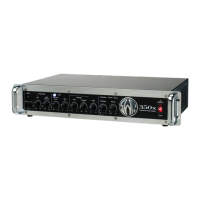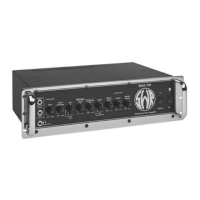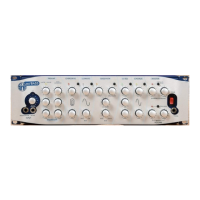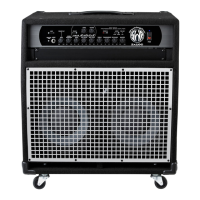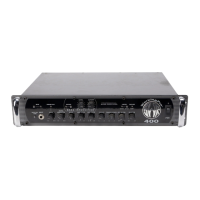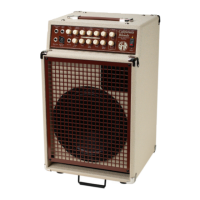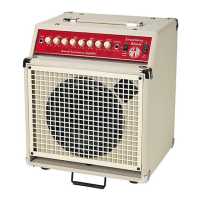16 • 550x
XLR MODE SWITCH (LINE/DIRECT/DIRECT + SUB)
This three-position switch determines the signal present at the Balanced (XLR) Output jack as described in the section directly
above. In simple terms:
1. Direct = pre-EQ and SubWave™, post-first tube stage
2. Line = post-EQ and SubWave™
3. Direct + Sub = pre-EQ/post-first tube stage blended with SubWave™
Make sure the switch is set either to full left, full right or center to avoid an intermittent condition.
XLR PAD CONTROL
This control sets the level present at the Balanced (XLR) Output. Turning the control counter-clockwise reduces the overall
level, while turning the control clockwise boosts the overall level. It should be noted that turning the control fully counter-clock-
wise to "Min" does not fully defeat the signal. This is normal, as the XLR Pad is designed to provide a range of usable levels to
be sent to a front-of-house or studio mixing console.
XLR GROUND/LIFT SWITCH
Sometimes connecting to certain mixing boards or studio consoles with non-standard XLR wiring can cause a ground loop.
Your 550x has a push-button switch for lifting the ground on the Balanced (XLR) Output. (It affects no other outputs.) Pushing
on the switch will change the mode of operation. When the switch is in the "out" position (default setting from the factory),
ground is on Pin 1 of the Balanced Output jack as normal. When the switch is in the "in" position, the ground is lifted from Pin
1 of this output. If a persistent hum exists after trying both positions of the ground lift, there is probably:
1. a bad cable or connection somewhere between your Balanced Output jack and the snake leading
to the mixing console
2. a dirty or miswired A/C socket
3. mis-wired or poorly wired A/C in the building
4. fluorescent lighting directly above you or in close proximity (especially when using single-coil pick
ups)
5. a cell phone in your right pocket that's interacting with the electronics in your bass (don't laugh,
this actually happens!)
But, in the case of a true ground loop, this switch can often times solve the problem.
TUNER OUT
The Tuner Out function allows the user to plug their instrument tuner into this jack and "tune up" without having to unplug and
go back and forth from amp to tuner. This feature is totally isolated from the rest of the preamp and will function regardless
of the settings on the front panel. Being isolated on a side chain avoids loading down of the instrument, which can cause a
loss in dynamic range.
To use this feature, connect a shielded patch cord from the Tuner Out jack on your 550x to the input jack on your tuner. Turn
the amplifier on and you're ready to go. If you do not wish to monitor your sound during the tuning process, you may turn
down the Master Volume.
EFFECTS LOOP (FOR EXTERNAL EFFECTS DEVICES)
As mentioned previously in the "Effects Blend Control" section of the manual, the Effects Blend circuit in your 550x is similar
to that used on recording consoles, with the effects loop on a "side chain" to the normal circuit. Unless the Effects Blend con-
trol is set to the full "wet" position, you will always get the full sound of your instrument AND get the diversity an external
effects unit offers. Use of the effects loop will reduce the noise generated by external effects units (as compared to using the
effect between your instrument and the input jack, though many people use it in this fashion anyway). This is because the loop
is after the preamp gain stages.
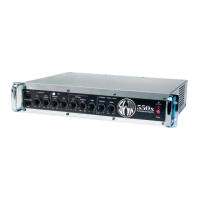
